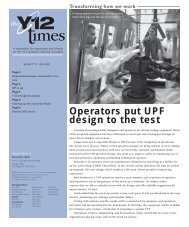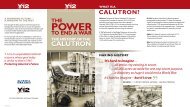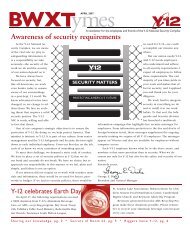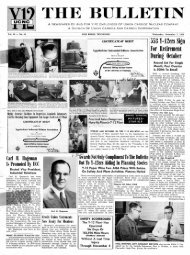March - Y-12 National Security Complex - U.S. Department of Energy
March - Y-12 National Security Complex - U.S. Department of Energy
March - Y-12 National Security Complex - U.S. Department of Energy
You also want an ePaper? Increase the reach of your titles
YUMPU automatically turns print PDFs into web optimized ePapers that Google loves.
MISSION, cont. from pg. 1Nuclear Materials Control and Accountabilityreceived an “Excellent” having implementedeffective material surveillance, iteminventory and process monitoring programs.The report stated that NMC&A “continues tobe recognized as a leader within theU.S. <strong>Department</strong> <strong>of</strong> <strong>Energy</strong>.”Institutional Management andBusinessThis heading includes general management,business management, informationtechnology and contractor assurance; it wasrated as “Very Good.”Communications “continued to providehigh quality public affairs products insupport <strong>of</strong> the Y-<strong>12</strong> mission.” A Y-<strong>12</strong> MediaCenter was developed for use during emergencypublic communications activities.B&W Y-<strong>12</strong> provided “excellent sustainedsupport for Y-<strong>12</strong> modernization” initiatives,including support for the Stockpile Stewardshipand Management Plan and the EmergencyResponse Facility project.What this meansEach <strong>of</strong> the companies that manageand operate sites for NNSA typically do sounder an award fee structure, which meansthe companies and the government agreeto a potential amount <strong>of</strong> pr<strong>of</strong>it, or fee,which can be earned through demonstratedperformance. In Y-<strong>12</strong>’s instance, the totalavailable fee was a little more than $60 millionin 20<strong>12</strong>; B&W Y-<strong>12</strong> earned 58.9 percent<strong>of</strong> that, or about $35.8 million.President and General Manager ChuckSpencer said, “While these results are not upto our previous standards, it is important torealize that we have made significant progresssince the July 28 event and are <strong>of</strong>f to a verygood start in fiscal year 2013.“As I’ve said before, the best we can dois to perform to the best <strong>of</strong> our abilities everyday, and then go home satisfied that wewere safe and productive. And even thoughwe’re in a time <strong>of</strong> transition related to thecontract bid, it is imperative that we stayfocused on safely and successfully completingour tasks every day.”Site improvements<strong>of</strong> $490 million result from FIRPThe Facilitiesand InfrastructureRecapitalizationProgram has beena key component<strong>of</strong> modernizationand transformationefforts at Y-<strong>12</strong>. Sinceits inception in 2002,FIRP has invested$490 million in facilityand infrastructureupgrades. Theprogram concludedin December withcompletion <strong>of</strong> the finalfacility demolition,Building 9720-18.“FIRP workscope has includedrecapitalization, excessfacility dispositionand utility line-itemThe Potable Water System Upgradesprojects,” said MikeProject and Bear Creek Road PavingProject resulted from the Facilities andRichesin, programInfrastructure Recapitalization Program.manager.Recapitalizationactivities focused on upgrades to mission-essential facilities. One <strong>of</strong> the most notableachievements is the $40 million investment in ro<strong>of</strong> replacements that resulted in28 acres <strong>of</strong> new ro<strong>of</strong>ing.FIRP resources <strong>of</strong> $<strong>12</strong>0 million enabled the demolition <strong>of</strong> 321 excess buildings,reducing the site footprint by 1.4 million square feet and retiring $18 million indeferred maintenance. Facility dispositions at Y-<strong>12</strong> accounted for 47 percent <strong>of</strong> thenuclear security enterprise total square foot reduction goal <strong>of</strong> 3 million square feet.FIRP also sponsored three major utility line-item projects: Compressed AirUpgrades, Potable Water System Upgrades and Steam Plant Life Extension. Thesemodernization projects greatly improved operability and reliability <strong>of</strong> key utilitysystems that serve mission-critical infrastructure.Y-<strong>12</strong> addressed hundreds <strong>of</strong> sitewide infrastructure deficiencies to fulfill the FIRPmission. As the program came to an end, FIRP focused on closeout activities such asremoving abandoned utility poles and cables from demolition sites and refurbishingroadways heavily used during project execution.“Y-<strong>12</strong> has accomplished a huge amount <strong>of</strong> work under FIRP,” Richesin said, “butthere is much work still to be done. We are currently working with headquarters toestablish a new program that will continue infrastructure improvements to ensure Y-<strong>12</strong>missions are accomplished.”2








